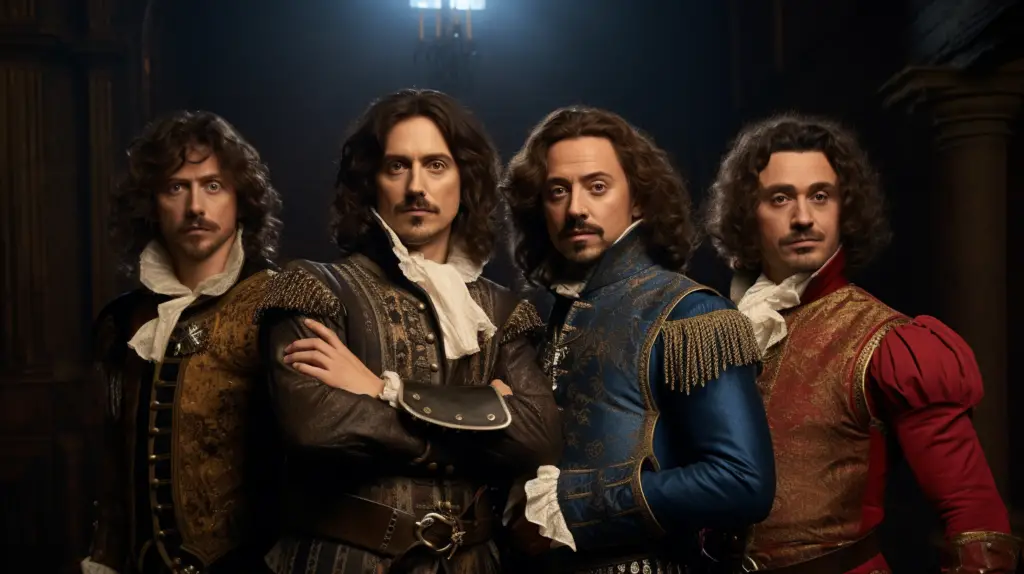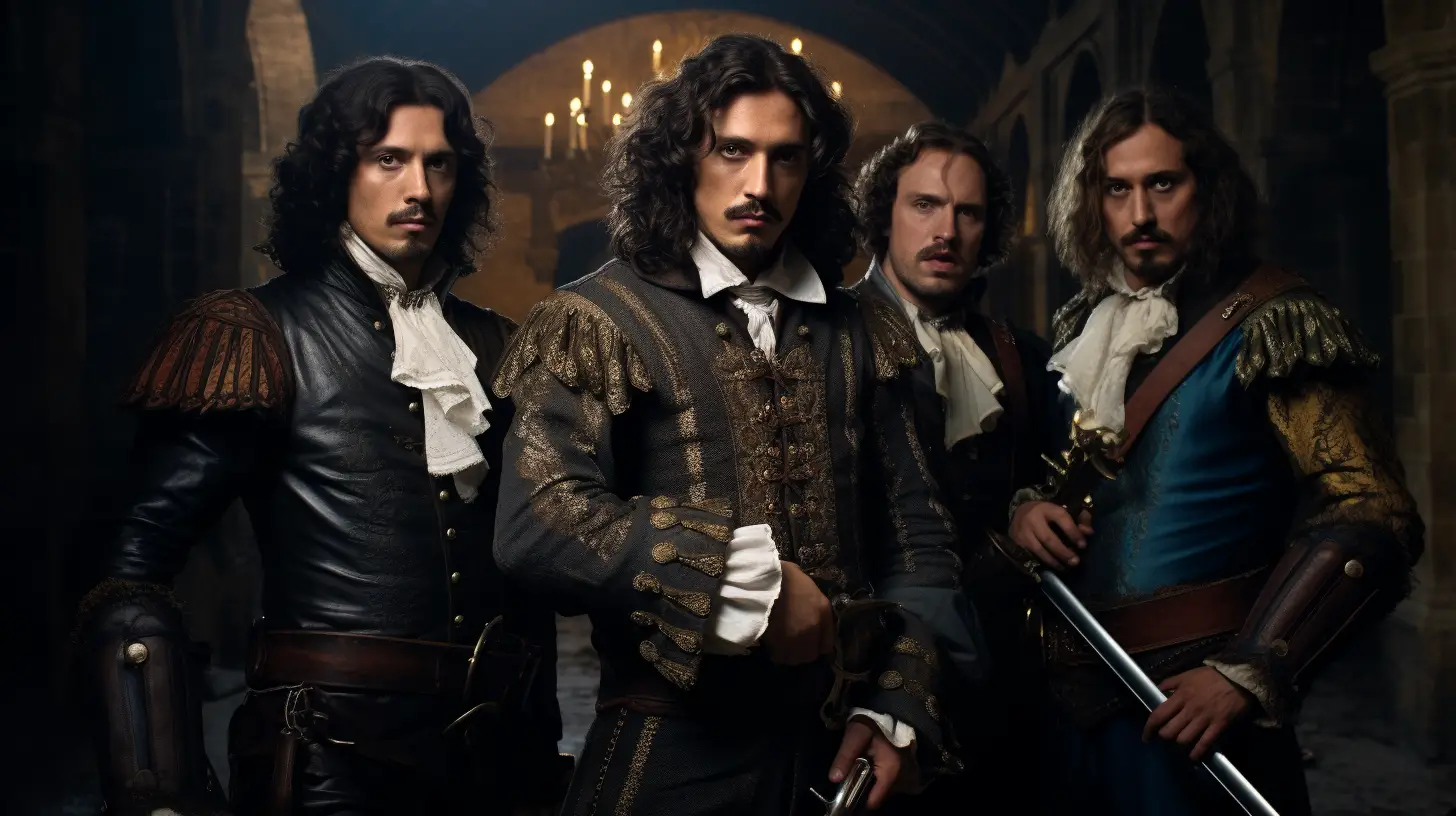Introduction to the book
“The Three Musketeers” is an immortal classic written by Alexandre Dumas, one of the most notable French authors of the 19th century. First published in serialized form in the magazine “Le Siècle” from March to July 1844, the novel has continued to mesmerize readers worldwide for nearly two centuries now. This novel’s allure lies in its captivating blend of adventure, friendship, loyalty, and intrigue, all set against the dramatic backdrop of 17th century France.

This article aims to provide a comprehensive summary and analysis of the novel while emphasizing its enduring appeal and the key elements that make it an undisputed classic in literature. “The Three Musketeers” offers intricate character developments, explores a dynamic historical backdrop, and delves into enduring themes that resonate with readers even today.
Summary of “The Three Musketeers”
“The Three Musketeers” is a coming-of-age story that follows the journey of the young, ambitious, and somewhat naive Gascon, D’Artagnan, who travels to Paris with dreams of becoming a musketeer. On his arrival, he accidentally offends three musketeers: Athos, Porthos, and Aramis, each having their unique personalities and histories. Athos is the most mature and secretive, Porthos loves luxury and is full of vanity, and Aramis is an aspiring priest, who is also a man of the world. D’Artagnan schedules duels with each, but they are interrupted by the Cardinal’s Guards, leading to a common fight that binds them as friends.
D’Artagnan, although not a musketeer yet, starts sharing in the trio’s adventures, hence forming the group that readers famously know as ‘The Four Musketeers.’ The novel revolves around their missions and adventures, all undertaken under the code ‘All for one, one for all,’ a profound symbol of their unwavering loyalty and friendship.
The main narrative thread involves the Musketeers’ struggle against the cunning Cardinal Richelieu. The Cardinal wishes to create a war between England and France, manipulating Queen Anne and her secret affair with the Duke of Buckingham. In one significant mission, the four friends must recover a diamond pendant the Queen had gifted to Buckingham to prevent the King from discovering her infidelity. It’s a race against time filled with peril, requiring all their resourcefulness, courage, and camaraderie.
As the story unfolds, D’Artagnan matures through his experiences, becoming a hero in his own right. The novel ends on a somewhat bittersweet note, with the Musketeers going their separate ways but not before affirming their enduring bond of friendship.
READ MORE: 25 Interesting Facts About “The Three Musketeers” | The Book and The Movies
“The Three Musketeers” Character Analysis
Dumas’s characters in “The Three Musketeers” are rich and complex. The protagonist, D’Artagnan, begins as a young, naive, and impulsive man but evolves into a courageous, loyal, and intelligent hero. His transformation occurs through his association with the three musketeers – Athos, Porthos, and Aramis – who all embody different aspects of humanity.
Athos, the most mysterious and wise, personifies the torments of a secret past. His secretive nature and often melancholic temperament highlight his deeply reflective personality. Porthos is boisterous, pleasure-loving, and vain, reflecting the inherent human desire for luxury and social status. Aramis, divided between his religious aspirations and his worldly desires, encapsulates the struggle between spiritual commitment and earthly pleasures.
READ MORE: Miyamoto Musashi Praying: His Spirituality, Beliefs and Practices
Historical Backdrop
Dumas cleverly uses a historical backdrop as a character in itself. The intricate political and social landscape of 17th-century France serves as a rich and tumultuous stage for the adventures of the four friends. The struggles between the monarchy, represented by King Louis XIII, and the church, represented by Cardinal Richelieu, fuel the plot’s progression.
The depiction of Cardinal Richelieu as the primary antagonist emphasizes the tension between the state and the church. He is portrayed as cunning and manipulative, using his religious position for political gains, thereby highlighting the corruption and manipulation rampant during this era.
“The Three Musketeers” Themes
“The Three Musketeers” is packed with enduring themes that resonate universally. The most prominent theme is that of unwavering friendship and loyalty. The famous line, ‘All for one, one for all,’ symbolizes the deep camaraderie and loyalty among D’Artagnan, Athos, Porthos, and Aramis. Despite numerous trials and tribulations, their friendship remains steadfast, signifying the human capacity for loyalty and mutual support.
The novel also explores the theme of honor, especially through the musketeers who live by a code of chivalry. Their exploits, often reckless, are driven by a sense of duty and honor, reflecting the societal norms of the time.
Additionally, the theme of ambition is evident in D’Artagnan’s journey from a naive provincial to a respected Musketeer of the King. His ambition pushes him to face various challenges, symbolizing the classic journey of a hero.
READ MORE: 25 Interesting Facts About Teenage Mutant Ninja Turtles (TMNT)
The Enduring Appeal of “The Three Musketeers”
“The Three Musketeers” remains an enduring classic because of its timeless themes of friendship, loyalty, and adventure. Readers are drawn to the bonds that the four main characters share, their camaraderie, and how they navigate through political intrigue and romantic escapades. Dumas’s storytelling is filled with a sense of high adventure, underlined by a subtle examination of human nature, making it appealing to readers of all ages.
Conclusion
“The Three Musketeers” stands as a monumental piece of literature that has transcended time and cultural boundaries. Its captivating story, combined with Dumas’s vibrant storytelling, brings to life a historical period filled with intrigue and adventure. It’s a tale of friendship and personal growth, underpinned by a grand narrative of royal conspiracy and political maneuvering. The vitality and charm of D’Artagnan, Athos, Porthos, and Aramis have ensured the novel’s popularity and its place as a beloved classic in literature.
Alexandre Dumas’s “The Three Musketeers” is not merely a novel of high adventure but a work layered with complex characters, a vibrant historical setting, and profound themes. The enduring appeal of the book lies in its universal exploration of friendship, loyalty, ambition, and honor, set against a tumultuous historical backdrop. The novel thus remains a rich resource for literary analysis, offering insights into both human nature and societal norms of the era it represents. Despite being a work of historical fiction, “The Three Musketeers” continues to resonate with modern readers, testifying to its timeless appeal.


